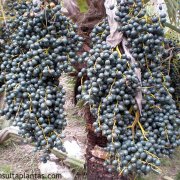Care of the palm tree Livistona chinensis or Chinese fan palm |
|
The genus Livistona, family Arecaceae, comprises 30 species of palm trees native to Africa, Asia and Australia. Some species are: Livistona chinensis, Livistona humilis, Livistona rotundifolia, Livistona australis, Livistona decipiens. Common names: Chinese fan palm, Fountain palm. This species is native to east Asia. They are palm trees that reach 9 meters (29.5 feet) in height; in pots they take on a bushy appearance. The decorative fan-shaped leaves have spiny petioles and flexible, bright light green leaflets. They produce long branched inflorescences with small cream-colored flowers. The fruits are rounded and dark blue. Chinese fan palm is used as indoor or greenhouse plants. In subtropical, tropical or Mediterranean climates it's used as isolated specimens in the garden. Livistona chinensis requires illuminated exposure without direct sun and average temperatures of 18-24 ºC (64-75 ºF). Below 15 ºC (59 ºF) the plant enters a period of rest; water only to prevent the substrate from drying out completely. The soil can be a mixture of 1/3 peat, 1/3 leaf mulch, and 1/3 coarse sand. Transplant in spring if the roots show through the base of the pot. Water regularly with lime-free water, waiting for the substrate surface to dry. Once a week it's advisable to clean the leaves with a sponge moistened in lime-free water. Fertilize during spring and summer with liquid mineral fertilizer every 15 days. Fountain palm does not need pruning. Livistona chinensis can be attacked by mealybugs and mites if it suffers from drought. Chinese fan palm propagates from seeds soaked several days before sowing; it's a slow process that takes several months. |
Images of the palm tree Livistona chinensis or Chinese fan palm |
Find plants
Livistona chinensis or Chinese fan palm | Care and Growing
© 2026 FavThemes



